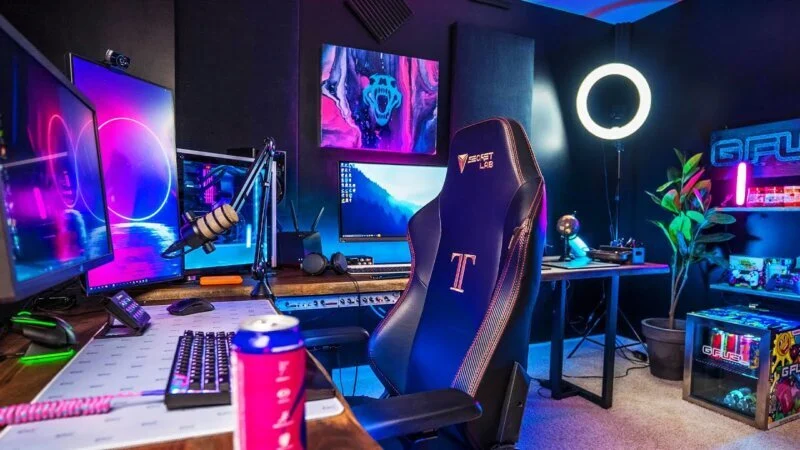Introduction: The GPU – Heart of Performance
Think about the most demanding tasks on your computer. What makes stunningly realistic video games possible? What powers the complex artificial intelligence changing our world? The answer lies in a single, critical component: the Graphics Processing Unit, or GPU. These powerful chips are no longer just about rendering pixels; they’re the engines driving computational breakthroughs. Today, we see GPUs powering two major arenas: the immersive worlds of high-performance gaming and the transformative capabilities of professional AI and machine learning workloads. This blog aims to do two things: guide you in finding a good gaming GPU for your needs, and then explore the vastly different, high-stakes world of enterprise AI, where managing GPU resources becomes a critical challenge demanding specialized solutions like WhaleFlux.
Section 1: Demystifying the “Good Gaming GPU”
The question “What’s a good GPU for gaming?” pops up constantly. The answer, however, isn’t one-size-fits-all. It depends entirely on your specific goals and setup.
Subsection 1.1: Defining “Good” for Gamers
So, what is a good gaming GPU? Fundamentally, it’s a card that delivers the visual experience you desire, smoothly and reliably, without breaking your budget. Key factors determine this:
- Target Resolution: This is paramount. Pushing pixels at 1080p (Full HD) is far less demanding than 1440p (QHD) or especially 4K (Ultra HD). A “good” GPU for 1080p might struggle at 4K.
- Target Frame Rate (FPS): Do you crave silky-smooth 60 FPS, competitive 144 FPS, or ultra-fluid 240+ FPS? Higher FPS requires significantly more GPU power.
- Game Settings: Are you happy with Medium settings for better performance, or do you demand Ultra settings with all the eye candy turned on? Higher settings exponentially increase GPU load.
- Budget: Ultimately, your spending limit heavily dictates the options available. Value for money is key.
Subsection 1.2: GPU Options for Gamers
NVIDIA Choices:
NVIDIA’s GeForce RTX series dominates the high end. The RTX 4090 is currently the undisputed king for enthusiasts seeking maximum performance at 4K or ultra-high refresh rates. Further down the stack, cards like the RTX 4080, RTX 4070 Ti/Super, and RTX 4070/Super offer excellent performance at lower price points for 1440p and high-refresh 1080p. The RTX 4060 series targets solid 1080p gaming.
Focus on 1080p:
Answering “What’s a good GPU for 1080p gaming?” specifically: Look at the current generation’s mid-range offerings. NVIDIA’s RTX 4060 or RTX 4060 Ti (8GB) are excellent starting points. These cards deliver smooth 60+ FPS at 1080p with High/Ultra settings in most modern titles. Previous generation cards like the RTX 3060 can also provide great 1080p value if found at a significant discount.
Subsection 1.3: Keeping Your Cool – GPU Temperatures
A hot topic (pun intended!) for gamers is “What’s a good temp for a GPU while gaming?” or “What’s a good temperature for my GPU under load?”
Safe Operating Ranges:
Modern GPUs are designed to handle heat, but cooler is generally better for longevity and sustained performance. As a rule of thumb:
- Below 80°C: Excellent. Your cooling is working very well.
- 80°C to 85°C: Generally considered safe and normal under heavy load for most modern GPUs. Performance shouldn’t be throttled significantly here.
- Above 85°C – 90°C: Getting warm. While many cards can technically operate here (often up to 95°C+ is the thermal throttle limit), it’s less than ideal for long-term health or peak boost clocks. Aim to improve cooling if consistently hitting this range.
- Above 90°C: Cause for concern. Investigate cooling immediately (dust, fan failure, poor case airflow).
Factors Affecting Temperature:
- Case Airflow: This is critical. A well-ventilated case with good intake and exhaust fans pulls cool air in and pushes hot air out efficiently. A cramped or poorly ventilated case traps heat.
- GPU Cooling Solution: Cards come with different coolers – dual-fan, triple-fan, or even liquid-cooled models. Larger, more robust coolers generally dissipate heat better.
- Ambient Room Temperature: If your room is hot, your components will run hotter.
- Workload Intensity: Running a graphically intense game at 4K Ultra settings will generate significantly more heat than browsing the web or playing an older game.
Monitoring tools like MSI Afterburner or HWMonitor are essential for keeping an eye on your GPU temps during gameplay.
Section 2: Beyond Gaming – The GPU Demands of Enterprise AI
While gamers focus on rendering the next frame, a different kind of GPU revolution is powering the future: Artificial Intelligence. However, the demands placed on GPUs by enterprise AI are on an entirely different scale compared to gaming.
Massive Computational Power:
Training large language models (LLMs) like those behind ChatGPT or complex AI models for scientific research, medical imaging, or autonomous driving requires processing petabytes of data through billions of parameters. This demands raw computational power far exceeding even the most demanding game. A single GPU, even an RTX 4090, is woefully inadequate.
The Need for Scale – Multi-GPU Clusters:
Enterprise AI runs on clusters. Not just two or three GPUs, but dozens or even hundreds of the most powerful data center-class GPUs working in parallel. Think NVIDIA’s H100, H200, and A100 Tensor Core GPUs – beasts designed specifically for AI acceleration, featuring technologies like NVLink for ultra-fast interconnects and massive amounts of high-bandwidth memory (HBM) crucial for handling large model parameters.
The Cost Challenge:
Acquiring, powering, and cooling racks full of H100s or A100s represents a colossal capital expenditure (CapEx). Renting equivalent cloud GPU instances (often powered by these same chips) incurs massive operational expenses (OpEx) that can quickly spiral out of control, especially with idle resources.
Management Complexity:
Simply having the hardware isn’t enough. Efficiently scheduling diverse AI workloads (training jobs, inference serving, experimentation) across a cluster is incredibly complex. Orchestrating tasks, managing dependencies, ensuring data pipelines feed the GPUs, and preventing bottlenecks requires sophisticated software – a far cry from launching a game on a single PC.
Speed and Stability are Mission-Critical:
For AI businesses, slow model training delays product launches and innovation. Unstable inference (e.g., an AI chatbot going down) directly impacts customers and revenue. Downtime or inefficient resource use translates directly to lost money and competitive disadvantage.
Pain Point Highlight: Just like a gamer needs the right single GPU to match their monitor and game settings, AI businesses desperately need optimal access and intelligent management of vast clusters of the most powerful GPUs to stay competitive and cost-effective. The challenge isn’t just having the hardware; it’s squeezing every drop of value from this incredibly expensive resource.
Section 3: Optimizing Enterprise GPU Power: Introducing WhaleFlux
This is where the game changes for AI enterprises. Meet WhaleFlux: the intelligent GPU resource management platform designed exclusively for AI/ML businesses. WhaleFlux’s core mission is simple but powerful: maximize efficiency and Return on Investment (ROI) for your high-value GPU infrastructure, letting you focus on building amazing AI, not managing hardware.
How WhaleFlux Solves the Critical AI GPU Challenges:
1. Smart Cluster Optimization – The Brain of Your GPU Fleet:
WhaleFlux acts as the intelligent orchestrator. It dynamically analyzes your AI workloads – whether it’s massive LLM training batches, real-time inference requests, or smaller experimentation jobs – and allocates them across your entire cluster of GPUs (including NVIDIA H100, H200, A100, or even powerful RTX 4090s) for peak utilization. Think of it as hyper-advanced task management on an industrial scale, constantly ensuring no GPU sits idle while another is overloaded. This goes far beyond anything needed for single-GPU gaming.
2. Significant Cost Reduction:
Idle GPUs are money burning a hole in your budget. By maximizing cluster utilization and minimizing wasted resources, WhaleFlux dramatically lowers your cloud computing costs if you rent, or significantly improves the ROI on your purchased hardware. You pay for power, not for GPUs gathering digital dust.
3. Enhanced Speed & Stability:
Bottlenecks and inefficient scheduling slow down model development and deployment. WhaleFlux streamlines the process, ensuring workloads get the resources they need when they need them. This leads to faster training cycles, quicker time-to-market for AI features, and rock-solid stability for inference serving, preventing costly downtime.
4. Access to High-End GPUs:
WhaleFlux provides seamless access to the essential tools of the AI trade: top-tier data center GPUs like the NVIDIA H100, H200, and A100, crucial for cutting-edge LLMs and complex models. We also offer powerful options like the RTX 4090 for specific workloads or smaller-scale deployments.
5. Flexible Acquisition Model:
WhaleFlux understands the different needs of AI businesses. You can purchase GPUs for long-term, dedicated capacity. Alternatively, you can rent our H100, H200, A100, or RTX 4090 GPUs for sustained project needs. (Important Note: Rentals are designed for committed usage, with a minimum rental period of one month. We do not offer hourly billing.)
Key Benefit: WhaleFlux transforms GPU infrastructure from a complex, costly headache into a streamlined, optimized engine for AI innovation. WhaleFlux lets AI companies focus on what they do best: building the future with AI, not wrestling with infrastructure.
Conclusion: Choosing the Right Tool for the Job
Whether you’re a gamer meticulously selecting a GPU to hit 144 FPS at 1440p Ultra, or an AI pioneer pushing the boundaries of what large language models can achieve, understanding GPU needs and optimization is fundamental to success. However, the nature of the challenge differs vastly.
For the gamer, success hinges on choosing the right single graphics card – matching performance to resolution, frame rate, settings, and budget. It’s about personal performance.
For the AI enterprise, success hinges on unlocking the collective potential of clusters of the world’s most powerful GPUs like the NVIDIA H100 and A100. It’s about intelligent orchestration, maximizing efficiency across dozens or hundreds of chips, and controlling runaway costs. This demands specialized solutions far beyond individual hardware choices.
This is where WhaleFlux shines. It’s the essential tool that empowers AI businesses to harness the true power of enterprise-grade GPU clusters. By providing intelligent resource management, flexible access to critical hardware (H100, H200, A100, RTX 4090), and significant cost reductions, WhaleFlux drives the efficiency and savings necessary for sustainable AI innovation.
Ready to stop wrestling with GPU infrastructure and start accelerating your AI ambitions? Learn how WhaleFlux can optimize your AI infrastructure and unleash the full potential of your GPU resources.
FAQs
1. What makes a gaming GPU like the RTX 4090 different from enterprise AI GPUs like the H100?
While both are NVIDIA GPUs, gaming cards like the RTX 4090 prioritize real-time graphics and consumer use, whereas enterprise GPUs like the H100 feature specialized tensor cores, ECC memory, and optimized interconnects for sustained AI training in data center environments.
2. Can I use a gaming GPU for AI development and testing?
Absolutely. The RTX 4090 is excellent for AI prototyping and fine-tuning. However, for production-scale AI training, you’ll need enterprise-grade NVIDIA GPUs like A100 or H100, which you can access through WhaleFlux‘s managed clusters without significant upfront investment.
3. How important is VRAM when choosing between gaming and AI GPUs?
VRAM is crucial for AI – it determines model size and batch processing capability. While the RTX 4090’s 24GB is impressive for gaming, enterprise AI requires the 80-94GB capacity of NVIDIA’s data center GPUs like A100 and H100 available through WhaleFlux for large language model training.
4. What’s more cost-effective: building a multi-gaming GPU setup or using enterprise AI infrastructure?
For serious AI work, WhaleFlux‘s enterprise GPU access provides better long-term value. Our intelligent management optimizes multi-GPU clusters (from RTX 4090s to H100s), ensuring maximum utilization and stability while offering flexible monthly rental terms that avoid large capital expenditures.
5. How can small teams access enterprise-level NVIDIA GPUs for AI projects?
Through WhaleFlux‘s scalable GPU infrastructure service. We provide access to the full NVIDIA stack – from RTX 4090s for development to H100 systems for production – via monthly rental plans, with intelligent resource management that ensures optimal performance for your AI workloads without hourly billing complexity.

